Digital Poster
Progress & Challenges in RF Coils I
ISMRM & ISMRT Annual Meeting & Exhibition • 03-08 June 2023 • Toronto, ON, Canada

| Computer # | |||
|---|---|---|---|
4402.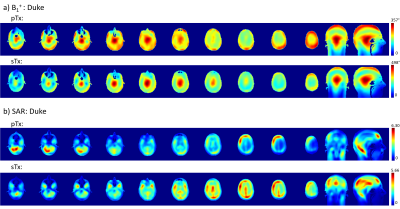 |
141 |
Comparison of the Optimization of a 60-channel Transmit Coil in
pTx and sTx mode at 7T
Andrea N Sajewski1,
Tales Santini1,
Tiago Martins1,
Jacob Berardinelli1,
and Tamer Ibrahim1
1University of Pittsburgh, Pittsburgh, PA, United States Keywords: In Silico, RF Arrays & Systems The recently developed 60-channel Tic-Tac-Toe transmit coil was analyzed for use in either single or parallel transmit systems at 7T. With the 60-channel TTT coil, excellent homogeneity can be achieved and safe levels of SAR can be provided regardless of which system (sTx or pTx) is used. |
|
4403.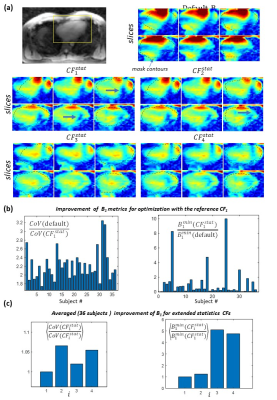 |
142 |
Tailored cost functions for improved static pTX-based B1+
shimming in 7T cardiac MRI.
Maxim Terekhov1,
David Lohr1,
Christoph Aigner2,
Sebastian Dietrich2,
Sebastian Schmitter2,
and Laura M. Schreiber1
1Chair of Molecular and Cellular Imaging, Comprehensive Heart Failure Center, University Hospital Würzburg, Wuerzburg, Germany, 2Physikalisch-Technische Bundesanstalt (PTB), Braunschweig and Berlin, Berlin, Germany Keywords: Parallel Transmit & Multiband, Cardiovascular Parallel transmit (pTX) technology is an emerging tool for improving of the B1+-field homogeneity in cardiac MRI (cMRI) at the ultra-high magnetic field. In this work, we propose a methodology to enhance the characteristics of the shaped B1+ field using a tailored cost function for the optimization procedure computing complex transmit vectors of magnitudes and phases for driving TX array. Using the cost functions (CF) based on the local B1 gradients with fine-tuning by weighting coefficients allows for considerable improvement of static pTX B1-shimming quality in compared to traditional CF using the coefficient-of-variation (CoV) of B1. |
|
4404.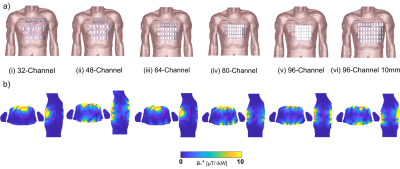 |
143 |
Static and dynamic parallel transmission (pTx) for human cardiac
MRI at 21.0 T
Bilguun Nurzed1,
Dennis Hieronymi1,
Thomas Wilhelm Eigentler1,
Christoph Stefan Aigner2,
Sebastian Schmitter2,
and Thoralf Niendorf1,3,4
1Max-Delbrück Center for Molecular Medicine in the Helmholtz Association, Berlin, Germany, 2Physikalisch-Technische Bundesanstalt (PTB), Braunschweig and Berlin, Germany, 3Experimental and Clinical Research Center (ECRC), a joint cooperation between the Charité Medical Faculty and the Max-Delbrück Center for Molecular Medicine, Berlin, Germany, 4MRI.TOOLS, Berlin, Germany Keywords: Shims, RF Arrays & Systems, Cardiovascular Transmission field inhomogeneities at ultrahigh and extreme field MRI can be offset using static or dynamic pTx. Responding to the challenges and recognizing the opportunities of cardiac MRI, this abstract examines the feasibility of parallel transmission (pTx) using self-grounded bow-tie (SGBT) RF array configurations for static and dynamic B1+ homogenization of the heart at 21.0T. Our results demonstrate that static pTx provides limited performance at 21.0 T, but dynamic pTx enables uniform heart excitation at 21.0T |
|
4405. |
144 |
Comparison of the transmit performance and Local SAR for
multi-row parallel transmit coil arrays at 3 Tesla human brain
MRI
Nejat Karadeniz1,
Jo Hajnal1,2,
and Özlem Ipek1
1Biomedical Engineering, King's College London, London, United Kingdom, 2Centre for the Developing Brain, King's College London, London, United Kingdom Keywords: RF Arrays & Systems, Safety MRI multi-row array coils can offer increased flexibility to control and tailor the RF field distribution through RF Shimming. The performance of various multi-row configurations of parallel-transmit (pTx) RF coil array for brain imaging at 3T is investigated using electromagnetic field simulations with digital human computational model for overlapping and non-overlapping loop coil elements in 16- to 24-channel single, double, triple-row arrays. We found that triple-row coil arrays improve the transmit field homogeneity in the entire volume of the head. The double-row coil array offers the best SAR efficiency among other investigated coils. |
|
4406.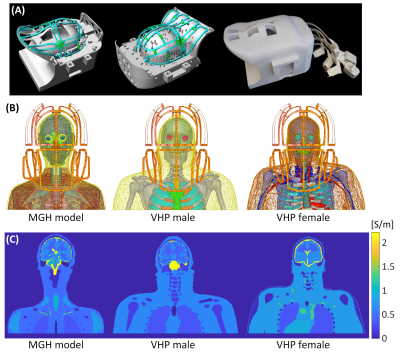 |
145 |
Design of a universal RF-shimming drive mode for head and neck
imaging at 7 Tesla using a 16-channel pTx array
Ehsan Kazemivalipour1,2,
Markus W. May3,4,
D. Rangaprakash1,2,
Berkin Bilgic1,2,5,
Jason P. Stockmann1,2,
Robert L. Barry1,2,
Boris Keil6,7,
Lawrence L. Wald1,2,5,
and Bastien Guerin1,2
1A. A. Martinos Center for Biomedical Imaging, Department of Radiology, Massachusetts General Hospital, Charlestown, MA, United States, 2Harvard Medical School, Boston, MA, United States, 3Erwin L. Hahn Institute for MRI, University Duisburg-Essen, Essen, Germany, 4High-Field and Hybrid MR Imaging, University Hospital Essen, Essen, Germany, 5Harvard-MIT Division of Health Sciences Technology, Cambridge, MA, United States, 6Institute of Medical Physics and Radiation Protection, Department of Life Science Engineering, Mittelhessen University of Applied Sciences, Giessen, Germany, 7Center for Mind, Brain and Behavior (CMBB), Philipps-University Marburg, Marburg, Germany Keywords: RF Pulse Design & Fields, RF Pulse Design & Fields We calculate “universal” RF-shimming excitations that provide maximum B1+ coverage and homogeneity across the brain & c-spine using a patient-friendly 16-channel pTx array. We simulated three body models and three z-positions to ensure robustness to both B1+ and SAR variation across a range of head/neck sizes and shapes (universal design). We provide two solutions, both of which may be saved on the scanner: a low-SAR solution that improves flip-angle uniformity by 13% compared to the BC mode excitation (same SAR) and a high-SAR excitation that improves flip-angle non-uniformity by 25% at the cost of a 2x local SAR increase. |
|
4407.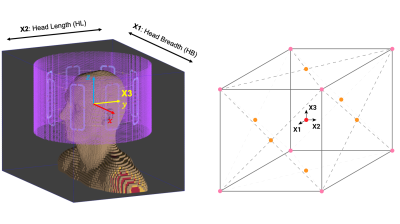 |
146 |
Efficient Use of Specific Absorption Rate Limits Through
Sub-Population Universal Pulses in Parallel Transmission
Igor Tyshchenko1,
Simon Lévy2,
Jin Jin3,
Bahman Tahayori4,
and Leigh A. Johnston1
1Department of Biomedical Engineering, The University of Melbourne, Melbourne, Australia, 2MR Research Collaborations, Siemens Healthcare Pty Ltd, Melbourne, Australia, 3MR Research Collaborations, Siemens Healthcare Pty Ltd, Brisbane, Australia, 4The Florey Institute of Neuroscience and Mental Health, Melbourne, Australia Keywords: Parallel Transmit & Multiband, Parallel Transmit & Multiband, Universal pulses, safety margins, 7T MRI Universal pulse (UP) design in parallel transmit (pTx) imaging is a calibration-free technique that can effectively mitigate the radiofrequency (RF) field inhomogeneity over a population in ultra-high field MRI. In this work, we explore a middle-ground approach of using sub-population UPs. Assuming the entire population is divided into sub-populations by grouping similar anatomical shapes and positions, UPs can thus be designed with reduced intersubject variability. In this preliminary study of head imaging, it is demonstrated that sub-populations of various sizes centred at the mean shape and position can reduce safety margins and improve UP’s performance. |
|
4408.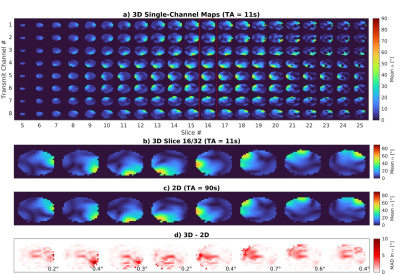 |
147 |
Accelerated Volumetric Multi-Channel pTx B1+ Mapping at 7T for
the Brain and Heart
James L. Kent1,
Ladislav Valkovič2,3,
Iulius Dragonu4,
Mark Chiew1,5,6,
and Aaron T. Hess1
1Wellcome Centre for Integrative Neuroimaging, FMRIB, Nuffield Department of Clinical Neurosciences, University of Oxford, Oxford, United Kingdom, 2Oxford Centre for Clinical Magnetic Resonance Research, John Radcliffe Hospital, University of Oxford, Oxford, United Kingdom, 3Department of Imaging Methods, Institute of Measurement Science, Slovak Academy of Sciences, Bratislava, Slovakia, 4Research & Collaborations GB&I, Siemens Healthcare Ltd, Camberley, United Kingdom, 5Department of Medical Biophysics, University of Toronto, Toronto, ON, Canada, 6Physical Sciences, Sunnybrook Research Institute, Toronto, ON, Canada Keywords: Parallel Transmit & Multiband, Parallel Transmit & Multiband Ultra-high field MRI with parallel transmit offers significant advantages but B1+ maps are required to utilize its potential. Acquiring B1+ maps for each channel is time-consuming and limits the application of ultra-high field in clinical practice. In this abstract we present an approach to acquire full 3D multi-channel B1+ maps in 11 seconds. We do this by employing a time-interleaved acquisition of modes strategy using undersampled relative maps and two fast undersampled Sandwich B1+ maps all reconstructed using TxLR, a calibrationless reconstruction for transmit field maps. We demonstrate this approach with simulations and scans in phantom and in the brain. |
|
4409.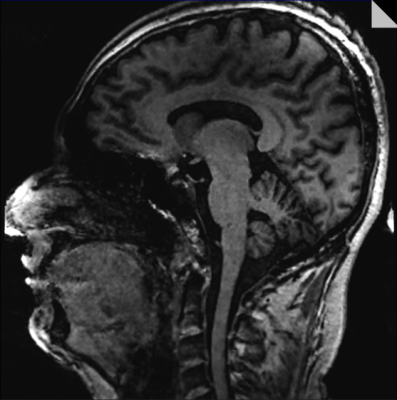 |
148 |
An 8-Parallel Transmit 32-Receive Array Head Coil for Clinical
Use at 7.0 Tesla
Alexander Smerglia1,
Labros Petropoulos1,
Xiaoyu Yang1,
Tsinghua Zheng1,
Paul Taylor1,
Blaise Whitesell1,
Jagjit Sidhu2,
Ken Sakaie2,
and Mark Lowe2
1Quality Electrodynamics (QED), Mayfield, OH, United States, 2Imaging Institute, Cleveland Clinic, Cleveland, OH, United States Keywords: Parallel Transmit & Multiband, Brain An 8-parallel transmit 32-Rx head coil was built and evaluated for performance in high-field MRI. The coil is comprised of an 8-rung curved degenerate birdcage transmitter and a 32-loop element receive array. The coil housing was designed with an anterior/posterior split and eye windows for patient comfort, and a sizable interior that can fit 99 percent of the general population. A volunteer was imaged to confirm transmit coverage, which includes the entire brain and upper cervical spine. Good B1 uniformity, and improved transmit efficiency over previously built non-curved Tx head coils were also confirmed. |
|
4410.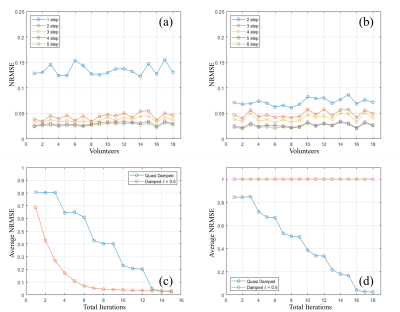 |
149 |
Quasi-Damped Newton’s Method for Large Flip Angle Universal
Pulse Design Using Parallel Transmission at 9.4T
Celik Boga1,
Ole Geldschlager2,
and Anke Henning1
1UT Southwestern Medical Center, Dallas, TX, United States, 2Max Planck Institute for Biological Cybernetics, Tuebingen, Germany Keywords: RF Pulse Design & Fields, High-Field MRI The Universal Pulse (UP) concept to parallel transmission radiofrequency (RF) pulse design was introduced to avoid time consuming B1+ and ΔB0 data acquisition before each clinical scan. Introduced large flip angle design methods utilize kT-point trajectories and small tip angle approximation. In this work, new quasi damping scheme for Newton's methods method is introduced for large flip angle universal pulse design using numerical solution of the Bloch equation. Introduced quasi-damping scheme can be utilized in large flip angle Universal Pulse design for all flip angles including 180o pulses, without the loss of performance. |
|
4411.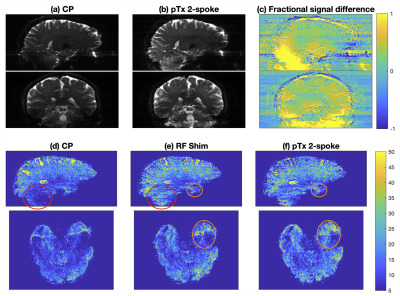 |
150 |
Comparing parallel transmit 2-spoke against circularly polarized
pulses for 7T whole brain diffusion MRI
Minghao Zhang1,
Belinda Ding1,2,
Iulius Dragonu2,
Patrick Liebig3,
Robin M. Heidemann3,
and Christopher T. Rodgers1
1Wolfson Brain Imaging Centre, University of Cambridge, Cambridge, United Kingdom, 2Siemens Healthcare Limited, Camberley, United Kingdom, 3Siemens Healthcare GmbH, Erlangen, Germany Keywords: Parallel Transmit & Multiband, Diffusion Tensor Imaging Diffusion MRI (dMRI) is inherently limited by SNR. 7T scans increase intrinsic SNR but suffer from regions of signal dropout, especially in temporal lobes and cerebellum. We applied dynamic parallel transmit (pTx) to allow whole-brain 7T dMRI and scanned 7 volunteers comparing pTx 2-spoke and circularly polarized pulses. PTx 2-spoke scans increased whole-brain mean temporal SNR increased by 22%, produced cleaner fractional anisotropy maps, and reduced fiber estimation uncertainty by 4% (P=0.016) for first fibers and 2% (P<0.001) for second fibers. However, less restrictive SAR limits will be needed for clinical translation of our approach due to long scan time. |
|
4412. |
151 |
RF mode switching based Tx coil system for B1+ homogeneity
mitigation at 7T: basic concept and preliminary study
Shin-ichi Urayama1,
Masaki Fukunaga2,
and Martijn Cloos3
1Human Brain Research Center, Graduate School of Medicine, Kyoto University, Kyoto, Japan, 2National Institute for Physiological Sciences, Okazaki, Japan, 3University of Queensland, Brisbane, Australia Keywords: RF Arrays & Systems, RF Arrays & Systems, RF-mode, non-pTx To mitigate B1 inhomogeneity problems in ultra-high-field MRI, we proposed RF-mode switching technique which doesn’t need an expensive parallel transmit (pTx) system. As a preliminary study, we developed an RF-switching circuit (one of the main parts of the system) and validated its function through phantom experiments. The results showed that the switching function works well, although a certain degree of power-loss was observed both at bench (< -1dB) and on the images. We have re-designed a new switching circuit and will continue to the development to demonstrate this technique at a fraction of the cost of a pTx system. |
|
4413.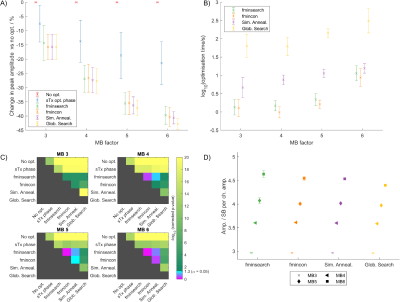 |
152 |
Optimisation of pulse-specific phase schedule reduces peak RF
amplitude in multiband parallel-transmit pulses
Belinda Ding1,2,
Sydney Nicole Williams1,
Minghao Zhang3,
Jürgen Herrler4,
Patrick Liebig4,
Iulius Dragonu5,
Radhouene Neji5,
Christopher T. Rodgers3,
and David A Porter1
1Imaging Centre of Excellence, University of Glasgow, Glasgow, Scotland, 2Siemens Healthcare Ltd., Glasgow, United Kingdom, 3Wolfson Brain Imaging Centre, University of Cambridge, Cambridge, United Kingdom, 4Siemens Healthcare GmbH, Erlangen, Germany, 5Siemens Healthcare Ltd., London, United Kingdom Keywords: Parallel Transmit & Multiband, Parallel Transmit & Multiband, phase schedule Multiband(MB) imaging can greatly reduce scan time, but MB pulses often encounter peak amplitude constraints. An optimal phase schedule has been published for traditional single-transmit (sTx) RF pulses. However, after an initial evaluation, we found that it only has marginal benefits for parallel-transmit (pTx) pulses. We compared four common optimisation algorithms (fmincon, fminsearch, simmulated annealing, global search) to determine the most suitable algorithm for choosing the best offset phases for a pTx pulse. Overall, fmincon efficiently selected the optimal phase schedule of a pTx pulse and lowered peak amplitude by an average of 15% when MB-factor=3. |
|
4414.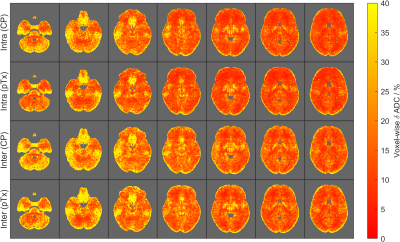 |
153 |
Slice-specific B1 shimming can improve the repeatability of
multi-shot, diffusion-weighted imaging at 7T
Belinda Ding1,2,
Sydney Nicole Williams1,
Iulius Dragonu3,
Jürgen Herrler4,
Sarah Allwood-Spiers5,
Patrick Liebig4,
and David A Porter1
1Imaging Centre of Excellence, University of Glasgow, Glasgow, Scotland, 2Siemens Healthcare Ltd., Glasgow, United Kingdom, 3Siemens Healthcare Ltd., London, United Kingdom, 4Siemens Healthcare GmbH, Erlangen, Germany, 5NHS Greater Clyde and Glasgow, Glasgow, Scotland Keywords: Parallel Transmit & Multiband, Diffusion/other diffusion imaging techniques, high-field, 7T, DWI, repeatability Parallel transmission (pTx) can significantly improve readout-segment EPI (rsEPI) diffusion-weighted imaging (DWI) at 7T when compared to the non-pTx sequence. However, no study has been done to assess the repeatability of pTx-DWI. Thus, we conducted a test-retest study to evaluate the impact pTx pulses have on the repeatability of ADC measures in a rsEPI[DP1] DWI sequence at 7T. Overall, pTx-DWI had higher SNR and can potentially improve the repeatability for intra- and inter-session ADC measures even when different B1-shim coefficients are used for different sessions. This suggests that pTx has an important role in quantittaive imaging studies at 7T. |
|
4415.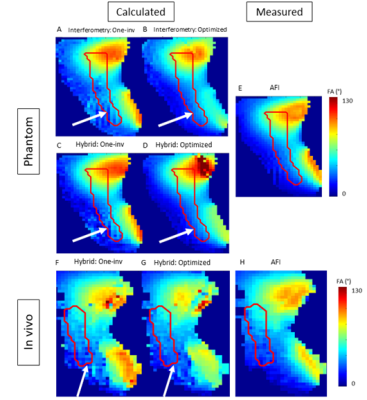 |
154 |
Optimized interferometric encoding of presaturated TurboFLASH
B1-mapping for pTx at 7T MRI: Application to T1-mapping in the
spinal cord
Aurelien Destruel1,2,3,
Franck Mauconduit4,
Aurélien Massire5,
Vincent Gras4,
and Virginie Callot1,2,3
1Aix-Marseille Univ, CNRS, CRMBM, Marseille, France, 2APHM, Hôpital Universitaire Timone, CEMEREM, Marseille, France, 3iLab-Spine, International Associated Laboratory, Montréal, Canada, Marseille, France, 4Paris-Saclay University, CEA, CNRS, BAOBAB, NeuroSpin, Gif-sur-yvette, France, 5Siemens Healthcare SAS, Saint-Denis, France Keywords: RF Pulse Design & Fields, Spinal Cord One of the best solutions to B1 inhomogeneities observed at ultra-high field MRI is to use parallel transmit techniques (pTx). However, fast and accurate knowledge of the B1+ is required. The presaturated TurboFLASH (satTFL)-based B1-mapping sequence, with interferometric encoding, has shown great promise due to its speed and reliability, but it was observed that its performance may drop when used with unconventional radiofrequency coils and applications. In this study, a novel optimization of the interferometric encoding is presented and applied to cervical spinal cord MRI at 7T. The impact of having improved B1-maps is evaluated on pTx MP2RAGE-based T1-mapping. |
|
4416.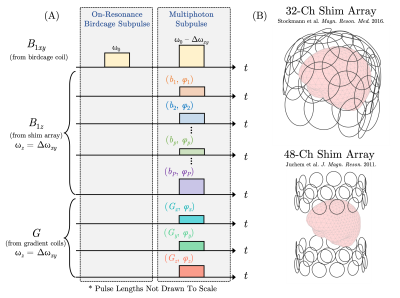 |
155 |
Multiphoton Parallel Transmission (MP-pTx)
John M Drago1,2,3,
Bastien Guerin2,3,
Stephen F Cauley2,3,
and Lawrence L Wald2,3,4
1Electrical Engineering and Computer Science, Massachusetts Institute of Technology, Cambridge, MA, United States, 2Harvard Medical School, Boston, MA, United States, 3A. A. Martinos Center for Biomedical Imaging, Charlestown, MA, United States, 4Health Sciences and Technology, Massachusetts Institute of Technology, Cambridge, MA, United States Keywords: RF Pulse Design & Fields, Parallel Transmit & Multiband We introduce multiphoton parallel transmission to mitigate nonuniform excitation in high-field MRI. Following an on-resonance birdcage subpulse, a multiphoton subpulse consisting of a single, off-resonance, high-frequency field from a birdcage coil, is supplemented with low-frequency parallel irradiation from a shim array. RF heating concerns are simplified compared to pTx, because only the birdcage coil produces significant SAR. Using a small-tip forward model, we optimize a nonconvex problem to find the amplitudes/phases of the low-frequency coils. Simulations demonstrate flip angle variation reduction across the brain ROI of 31.5% and NRMSE reduction of 42.0% compared to a conventional 7 T birdcage excitation. |
|
The International Society for Magnetic Resonance in Medicine is accredited by the Accreditation Council for Continuing Medical Education to provide continuing medical education for physicians.